Minerals/Carbonides
< Minerals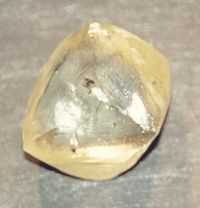
Carbonides are naturally occurring minerals composed of 50 atomic percent, or more, carbon. Carbonide-like minerals with greater than 25 at % carbon are also included. This separates carbon containing minerals from carbonates which are at most 25 at % carbon.
Diamonds
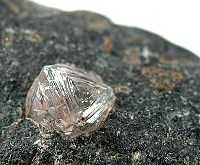
The diamond imaged on the right has been estimated to be just over 1.5 carats. It measures 5 mm on edge. Although it might seem small, it has wonderful visual impact because of the clarity and perch on matrix. Embedded perhaps 50% in the matrix, so you know it is real. What is more, you can look right through the diamond to the matrix underneath! Around the diamond is a thin white layer you sometimes see, which indicates not glue but rather an alteration in the surrounding rock due to the chemical heat of formation of the crystal and is a good indication of its origins as natural.
Graphites
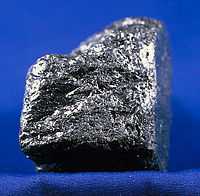
Graphite is a hexagonal form of carbon that often appears as tabular crystals.
Chaoites

Chaoites are another hexagonal form of native carbon. It occurs as "thin lamellae (3-15 microns wide), alternating with graphite and perpendicular to the {0001} face of graphite."[1]
"Occurs in association with graphite, zircon, and rutile in shocked graphite gneisses from Mottingen in the Ries Crater, Germany. Also observed from the Goalpara and Dyalpur carbonaceous chondrites."[1]
Lonsdaleites
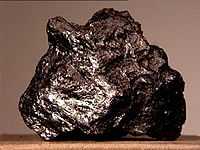
"The mineral Lonsdaleite is a translucent, brownish yellow and is made from the atoms of carbon but the arrangement of these atoms is different from the arrangement of carbon atoms in a diamond. [...] The mineral is very rare and is formed naturally whenever [...] graphite containing meteorites fall on the earth and hit the surface."[2]
"Found in the Canyon Diablo and Goalpara meteorites."[1]
Fullerites
Fullerite appears to be a tentative name for the mineral occurrence of buckyballs.
"By means of high-resoluton transmission electron microscopy, both C60 and C70 fullerenes have been found in a, carbon-rich Precambrian rock from Russia The fullerenes were confirmed by Fourier transform mass spectrometry with both laser desorption and thermal desorption/electron-capture methods to verify that the fullerenes were indeed present in the geological sample".[3]
Space carbons
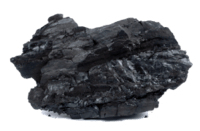
Apparently graphitic-like carbon particles such as shown in the image on the right have been found in space and brought back to Earth.
Organic minerals
An organic mineral appears to be a naturally occurring mineral containing one or more organic chemicals at a concentration of greater than 25 molecular %.
Carpathites

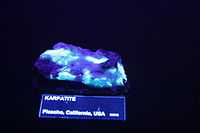
Carpathite (aka Karpatite) is a very rare organic species (C24H12).[1] It is a polycyclic aromatic hydrocarbon (PAH). This specimen is from the old Picacho Mercury Mine of California. It exhibits a radial spray of highly lustrous, canary-yellow carpathite lathes to 2.0 cm on drusy quartz. Another crossed cluster of crystals above reach 3.0 cm. It has 66.7 at % carbon.
Idrialites

With a formula of C22H14,[1] idrialites are about 61 at % carbon.
Idrialite is "a complex natural mineral composed entirely of cata-condensed polyaromatic hydrocarbons (PAHs), usually containing a thiophenic or aliphatic five-membered ring."[4]
Idrialite "(and also curtisite) represents more complex mixtures of chain-type PAHs with molecular weights ranging from 216 to 372 amu [5]."[4]
"Some of the bands in the idrialite spectra are attributed to specific vibrational modes of thiophene or fluorene-type PAHs, especially in the region bellow 1000 cm−1. These modes at 495, 705 and 750 cm−1 along with C–H or C–H2 stretching modes around 3000 cm−1 can be then used to distinguish such groups of PAHs in complicated organic mineral mixtures like idrialite."[4]
Idrialite may include benzonaphthothiophenes (chemical formula: C16H10S).[4]
Kratochvilites
Def. a "rare organic mineral [C14H10 or (C6H4)2CH2, a polymorph of fluorene], an orthorhombic hydrocarbon formed by combustion of coal or pyritic black shale deposits"[5]
Kratochvilites have about 58.3 at % carbon.
Moissanite
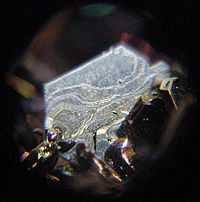
Moissanite is native SiC.[1]
Hoelites
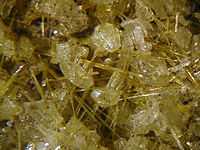
Hoelites are 50 at % carbon with a formula of (C6H4)2(CO)2.[1]
Abelsonites

Abelsonites have a chemical formula of NiC31H34N4, for 44.3 at % carbon.[1]
Simonellites
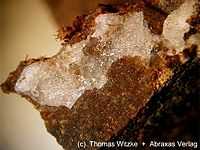
Def. an "orthorhombic-dipyramidal white mineral containing carbon and hydrogen [C19H24]"[6] is called a simonellite.
Simonellites have about 44.2 at % carbon.
Hartites
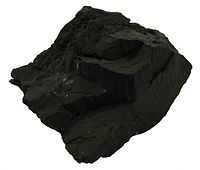
Hartites have about 37 at % carbon with a formula of C20H34.[1]
Fichtelites
Def. a "rare white monoclinic organic mineral, 7-isopropyl-1,4a-dimethyl-dodecahydro-1H-phenanthrene [C19H34], found in fossilized wood"[7] is called a fichtelite.
Also, occurs in "fossilized pine wood from a peat bog; in organic-rich modern marine sediment."[8]
Fichtelites have about 35.8 at % carbon.
Evenkites

Evenkite has about 32.4 at % carbon in its formula: (CH3)2(CH2)22.[1]
Original research
- See also: Original research inquiry and Research
Hypothesis:
- The easiest resource for specific elements is as a native element mineral.
- See also: Control groups, Proof of concept, and Proof of technology
See also
- Carbonates
- Carbonites
- Organic minerals
- Siliconides
References
- 1 2 3 4 5 6 7 8 9 10 Willard Lincoln Roberts, George Robert Rapp, Jr., and Julius Weber (1974). Encyclopedia of Minerals. 450 West 33rd Street, New York, New York 10001 USA: Van Nostrand Reinhold Company. pp. 121-2. ISBN 0-442-26820-3.
- ↑ payam (30 July 2013). "Top 10 Hardest Material in the world". Help Tips. Retrieved 2015-07-30.
- ↑ Peter R. Buseck, Semeon J. Tsipursky, and Robert Hettich (10 July 1992). "Fullerenes from the Geological Environment". Science 257 (5067): 215-7. doi:10.1126/science.257.5067.215. http://www.sciencemag.org/content/257/5067/215. Retrieved 2015-07-30.
- 1 2 3 4 Otakar Frank, Jan Jehlička and Howell G.M. Edwards (15 December 2007). "Raman spectroscopy as tool for the characterization of thio-polyaromatic hydrocarbons in organic minerals". Spectrochimica Acta Part A: Molecular and Biomolecular Spectroscopy 68 (4): 1065–9. doi:10.1016/j.saa.2006.12.033. http://www.sciencedirect.com/science/article/pii/S1386142506007621. Retrieved 2015-11-02.
- ↑ "kratochvilite, In: Wiktionary". San Francisco, California: Wikimedia Foundation, Inc. 19 June 2013. Retrieved 2015-01-09.
- ↑ "simonellite, In: Wiktionary". San Francisco, California: Wikimedia Foundation, Inc. 19 June 2013. Retrieved 2015-01-09.
- ↑ "fichtelite, In: Wiktionary". San Francisco, California: Wikimedia Foundation, Inc. 29 May 2014. Retrieved 2015-01-09.
- ↑ R. Ruff (2005). "Fichtelite". Mineral Data Publishing. Retrieved 2015-01-09.
External links
![]() This is a research project at http://en.wikiversity.org
This is a research project at http://en.wikiversity.org
| |
Educational level: this is a research resource. |
| |
Resource type: this resource is an article. |
| |
Resource type: this resource contains a lecture or lecture notes. |
| |
Subject classification: this is a Geology resource. |